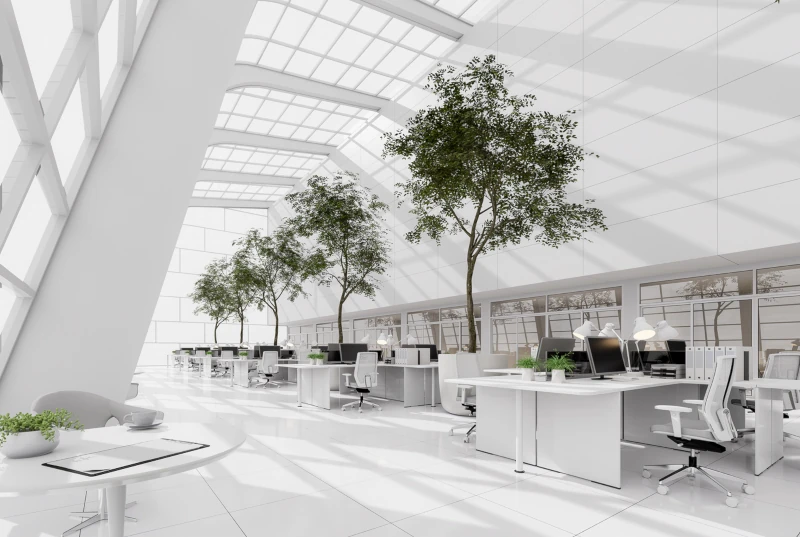It isn’t a stretch to say that the pandemic radically altered our concept of the modern office post-COVID. Once-thriving hubs of activity, like the financial district in San Francisco, have yet to recover from the shifts that took place.
In an earlier post, we highlighted the challenges facing architects and designers when attempting to transform vacant office buildings into housing.
What can companies do to encourage their workforce to return to the office for at least two, three, or even five days a week?
First, let’s bid a robust goodbye to the days of dense cubicles, static workstations and designs that do not consider employees’ needs. Today’s offices better be adaptable, health-conscious and deeply connected to employees’ well-being and engagement.
Looking at these challenges through the eyes of an architect, there are logical steps to transforming a pre-COVID office into a vibrant, post-COVID workspace that supports and engages a modern workforce.
Existing Space Assessment
As priorities change, so does the way we view space utilization. With an entire workforce in the office, all at the same time, using every bit of space took priority. That resulted in high-density seating, a focus on maximizing space efficiency over employee comfort, and few communal spaces. Any assessment will want to consider how the current space can be reconfigured to prioritize the introduction of natural elements, the flexibility of seating options, and upgrading areas to enhance technology, especially communication tools and software.
Going from Closed to Open Spaces, Why Choose?
In the decades before COVID, offices leaned heavily on one of two options: closed-off, warren-like cubicles or an open-plan with no dividers or privacy. A modern redesign aims to strike a balance, incorporating flexible spaces that can be adjusted based on the day’s needs.
Traffic Patterns
Remember the sometimes-congested entry points and narrow corridors of pre-COVID offices? They were perfect spots for traffic jams. A redesign can opt for wider, more open circulation paths to improve flow and accommodate social distancing if needed.
Flexible Design Options
Flexibility is the cornerstone of post-COVID office design. Whether your employees are working on-site full-time, remotely or in a hybrid capacity, the goal is to adapt readily to accommodate various working styles.
Rooms can transform for more than one purpose. Instead of dedicating rooms to a single function, the redesign can include multipurpose areas. Think in terms of open-space rooms serving as meeting rooms, break-out spaces or quiet zones. Moveable walls make this possible, enabling quick and easy reconfiguration.
Introducing Biophilic Design
Biophilic design is a fancy phrase for a simple concept, creating a greater connection to nature when designing interior spaces. Natural light ranks at the top of the list of ways to nurture that connection between employees and nature in their workspaces. This could mean repositioning workstations closer to windows, installing glass partitions or if possible, even adding skylights to bring in more daylight.
Indoor plants were once very much in vogue in the 1970s, shortly after Psychologist Erich Fromm first used the word biophilia in 1964. Incorporating plants and greenery throughout the office improves air quality and creates a more inviting and calming atmosphere. Vertical gardens, potted plants and natural materials like wood and stone are key elements in an effective redesign.
Prioritizing Health and Well-being
A redesign can advocate for features that promote a healthy work environment, both physically and mentally. The threat of airborne illnesses like COVID made us painfully aware of air quality and concerns about optimum wellness.
Improving ventilation and, in turn, air quality can mean upgrading the HVAC system to improve air filtration and circulation. Additionally, the use of air purifiers and plants known for their air-cleaning properties can also give a boost to enhancing indoor air quality.
Designing spaces specifically for wellness, like providing meditation rooms and nap pods, and, for some companies, adding small gyms can provide employees with areas to decompress and recharge. These spaces contribute to a healthier, more engaged workforce.
Integrating Technology
Technology’s role in the office took a major leap forward post-COVID. The redesigned office needs be equipped to support seamless collaboration and efficient work processes with the latest tech solutions.
Tools to facilitate collaboration are essential. Equipping meeting rooms with state-of-the-art video conferencing and interactive whiteboards ensures that all employees can participate fully in meetings and collaborative work, whether in the office or working remotely.
Finally, we can’t consider redesigns without understanding why many employers want their workforce in the office at least two days each week, and we can’t discount the willingness of a significant number of employees to do so.
“Ninety-eight percent of respondents would like to work remotely, at least some of the time, for the rest of their careers … 71 percent of companies are permanently allowing some type of remote work. And only 8 percent of respondents said their companies are not allowing any form of remote work.” Buffer’s 2023 State of Remote Work Report
While the future of remote work is not engraved in stone, all signs point to the continuation of hybrid work being the new model. So, if you are a company owner, CEO or manager hoping to entice your workers into the office any time soon, Gallup has some advice for you.
“Give people a compelling reason to come to the office. A policy is not an answer to why people should come to the office. Leaders need to develop a compelling workplace value proposition that represents the culture, benefits and interactions employees will experience on-site.”
If you design a welcoming, flexible environment that prioritizes their health and well-being while offering the latest in technology and a chance to connect with their managers and peers in meaningful ways, you’ll be ahead of the curve.


